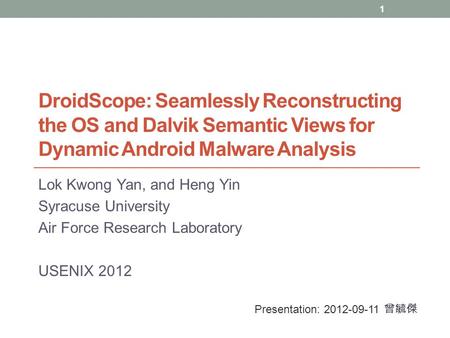


DroidScope: Seamlessly Reconstructing the OS and Dalvik Semantic Views for Dynamic Android Malware Analysis Lok Yan Heng Yin August 10, 2012
Android Java Components System Services Native Components Apps
Android Java Components System Services Native Components Apps
Motivation: Static Analysis Dalvik/Java Static Analysis: ded, Dexpler, soot, Woodpecker, DroidMoss Native Static Analysis: IDA, binutils, BAP
Motivation: Dynamic Analysis Android Analysis: TaintDroid, DroidRanger System Calls logcat, adb
Motivation: Dynamic Analysis External Analysis: Anubis, Ether, TEMU, …
DroidScope Overview
Goals Dynamic binary instrumentation for Android Leverage Android Emulator in SDK No changes to Android Virtual Devices External instrumentation Linux context Dalvik context Extensible: plugin-support / event-based interface Performance Partial JIT support Instrumentation optimization
Roadmap External instrumentation Linux context Dalvik context Extensible: plugin-support / event-based interface Evaluation Performance Usage
Linux Context: Identify App(s) Shadow task list pid, tid, uid, gid, euid, egid, parent pid, pgd, comm argv[0] Shadow memory map Address Space Layout Randomization (Ice Cream Sandwich) Update on fork, execve, clone, prctl and mmap2
Java/Dalvik View Dalvik virtual machine mterp Which Dalvik opcode? register machine (all on stack) 256 opcodes saved state, glue, pointed to by ARM R6, on stack in x86 mterp offset-addressing: fetch opcode then jump to (dvmAsmInstructionStart + opcode * 64) dvmAsmSisterStart for emulation overflow Which Dalvik opcode? Locate dvmAsmInstructionStart in shadow memory map Calculate opcode = (R15 - dvmAsmInstructionStart) / 64.
Just In Time (JIT) Compiler Designed to boost performance Triggered by counter - mterp is always the default Trace based Multiple basic blocks Multiple exits or chaining cells Complicates external introspection Complicates instrumentation
dvmGetCodeAddr(PC) != NULL Disabling JIT dvmGetCodeAddr(PC) != NULL
Roadmap External instrumentation Linux context Dalvik context Extensible: plugin-support / event-based interface Evaluation Performance Usage
Instrumentation Design Event based interface Execution: e.g. native and Dalvik instructions Status: updated shadow task list Query and Set, e.g. interpret and change cpu state Performance Example: Native instructions vs. Dalvik instructions Instrumentation Optimization
Dynamic Instrumentation Update PC Translate Execute inCache? yes no (un)registerCallback needFlush? flushType invalidateBlock(s) flushCache yes
Instrumentation
Dalvik Instruction Tracer (Example) 1. void opcode_callback(uint32_t opcode) { 2. printf("[%x] %s\n", GET_RPC, opcodeToStr(opcode)); 3. } 4. 5. void module_callback(int pid) { 6. if (bInitialized || (getIBase(pid) == 0)) 7. return; 8. 9. gva_t startAddr = 0, endAddr = 0xFFFFFFFF; 10. 11. addDisableJITRange(pid, startAddr, endAddr); 12. disableJITInit(getGetCodeAddrAddress(pid)); 13. addMterpOpcodesRange(pid, startAddr, endAddr); 14. dalvikMterpInit(getIBase(pid)); 15. registerDalvikInsnBeginCb(&opcode_callback); 16. bInitialized = 1; 17. } 18. 19. void _init() { 20. setTargetByName("com.andhuhu.fengyinchuanshuo"); 21. registerTargetModulesUpdatedCb(&module_callback); 22. } getModAddr(“dfk@classes.dex”, &startAddr, &endAddr);
Plugins API Tracer Native and Dalvik Instruction Tracers Taint Tracker System calls open, close, read, write, includes parameters and return values Native library calls Java API calls Java Strings converted to C Strings Native and Dalvik Instruction Tracers Taint Tracker Taints ARM instructions One bit per byte Data movement & Arithmetic instructions including barrel shifter Does not support control flow tainting
Roadmap External instrumentation Linux context Dalvik context Extensible: plugin-support / event-based interface Evaluation Performance Usage
Implementation Configuration QEMU 0.10.50 – part of Gingerbread SDK “user-eng” No changes to source Linux 2.6.29, QEMU kernel branch
Performance Evaluation Seven free benchmark Apps AnTuTu Benchmark (ABenchMark) by AnTuTu CaffeineMark by Ravi Reddy CF-Bench by Chainfire Mobile processor benchmark (Multicore) by Andrei Karpushonak Benchmark by Softweg Linpack by GreeneComputing Six tests repeated five times each Baseline NO-JIT Baseline – uses a build with JIT disabled at runtime Context Only API Tracer Dalvik Instruction Trace Taint Tracker
Select Performance Results APITracer vs. NOJIT Results are not perfect Dynamic Symbol Retrieval Overhead
Usage Evaluation Use DroidScope to analyze real world malware API Tracer Dalvik Instruction Tracer + dexdump Taint Tracker – taint IMEI/IMSI @ move_result_object after getIMEI/getIMSI Analyze included exploits Removed patches in Gingerbread Intercept system calls Native instruction tracer
Droid Kung Fu Three encrypted payloads Three execution methods ratc (Rage Against The Cage) killall (ratc wrapper) gjsvro (udev exploit) Three execution methods piped commands to a shell (default execution path) Runtime.exec() Java API (instrumented path) JNI to native library terminal emulator (instrumented path) Instrumented return values for isVersion221 and getPermission methods
Droid Kung Fu: TaintTracker
DroidDream Same payloads as DroidKungFu Two processes Normal droiddream process clears logcat droiddream:remote is malicious xor-encrypts private information before leaking Instrumented sys_connect and sys_write
Droid Dream: TaintTracker
DroidDream: crypt trace
Summary DroidScope Dynamic binary instrumentation for Android Built on Android Emulator in SDK External Introspection & Instrumentation support Four plugins API Tracer Native Instruction Tracer Dalvik Instruction Tracers TaintTracker Partial JIT support
Related Works Static Analysis Dynamic Analysis Introspection ded, Dexpler, soot Woodpecker, DroidMoss Dynamic Analysis TaintDroid DroidRanger PIN, Valgrind, DynamoRIO Anubis, TEMU, Ether, PinOS Introspection Virtuoso VMWatcher
Challenges JIT Emulation detection Full JIT support Flushing JIT cache Emulation detection Real Sensors: GPS, Microphone, etc. Bouncer Timing assumptions, timeouts, events Closed source systems, e.g. iOS
Q0. Where can I get DroidScope? Questions? Q0. Where can I get DroidScope?
ratc Vulnerability Three generation (stage) exploit setuid() fails when RLIMIT_NPROC reached adbd fails to verify setuid() success Three generation (stage) exploit Locate adbd in /proc and spawns child Child fork() processes until -11 (-EAGAIN) is returned then spawns child – continues fork() Grandchild kill() adbd and waits for process to re-spawn
ratc: exploit diagnosis
Symbol Information Native library symbols - Static From objdump of libraries Java symbols - Dynamic Dalvik data structures -> address of string Given address, load from Memory File mapped into memory dexdump as backup